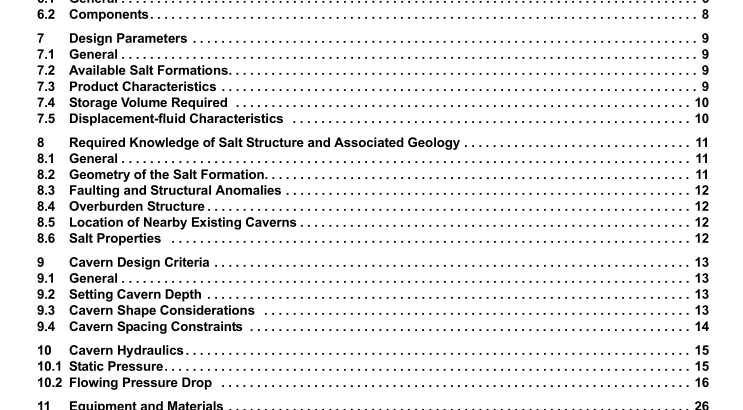API RP 1114:2013 pdf free download.Recommended Practice for the Design of Solution-mined Underground Storage Facilities
4 Overview of Underground Storage Storage of products in solution-mined salt caverns has been utilized in the United States since the late 1940s. Today, storage of hydrocarbon liquids and liquefied petroleum gases in caverns developed in both domal and bedded salt formations is utilized throughout the world. Salt caverns can act independently as long term, seasonal storage vessels; or they may serve as short term, operational storage. Caverns can also be inserted into the production plant/pipeline systems to prevent supply interruptions when maintenance or emergency shut downs occur or to “float” on pipelines to optimize operations.
Site selection for solution-mined underground storage is based on numerous considerations, including a study of the geologic formation to be utilized. Proper drilling and casing-cementing procedures are essential to ensure the integrity of the storage cavern. Cavern development is accomplished by injecting water to dissolve the salt mass and displace the resulting brine. Before the product is injected initially, the storage cavern is full of brine. Injecting product displaces brine and maintains a liquid filled cavern. Product is withdrawn from the cavern by displacing it with brine or water.
5 Applicable Rules and Regulations
The creation or operation of solution-mined underground storage facilities is often regulated by federal, state, or local codes, regulations, ordinances, or rules. A review of the applicable rules and regulations is required prior to or in the initial stages of design of a solution-mined underground storage facility.
6 Salt Storage Overview
6.1 General A solution-mined salt cavern for commodity storage is created through the planned solutioning of a naturally occurring bedded or domal salt formation. Solution mining simply requires exposing the salt formation by drilling a well, circulating fresh or low-salinity water in the well, and withdrawing the brine from the cavern. The salt in the formation dissolves, enlarging the well bore to form an even larger cavern.
The shape of the cavity depends on the solutioning procedure employed. The typical storage cavern resembles a cylinder, with the height several times greater than the diameter. The relatively small roof area enhances the probability of effective product recovery and minimizes the probability of the roof collapsing during service. Concentric tubing strings are generally used to move stored product in and out of the cavern. A large U-tube is created for the flow, and because of the differences in densities between the product stored and the brine, a manometer effect is created. A simplified salt-dome storage cavity is illustrated in Figure 1.
Injecting product is accomplished when the product is supplied to the wellhead at sufficient pressure to allow movement down the production casing and tubing annulus into the top of the cavity. This forces a corresponding movement of brine or water out of the cavity up the brine tubing string.
Product is withdrawn by reversing the injection process. In this case, brine is pumped into the cavity, forcing a corresponding movement of product out of the cavity up the tubing casing annulus.
Dry caverns do not use a displacement fluid and instead rely on downhole pumps to deliver product from the cavern. Dry caverns may be appropriate where high-ingress but low-egress flow rates are required.
6.2 Components
6.2.1 Tubing Strings The common tubing string configuration includes a single tubing string (brine string) concentrically suspended within the production casing or a combination of a tubing string and a blanket string concentrically suspended in the production casing. The blanket string should be considered if high corrosion rates are expected or if it is desirable to pull and inspect the casing at a later date. The production casing, tubing, and blanket casing (if so equipped) shall be designed to accommodate the required flow rates, cavern pressure limitations, and surface equipment capability. API RP 1114 pdf download.API RP 1114:2013 pdf free download
